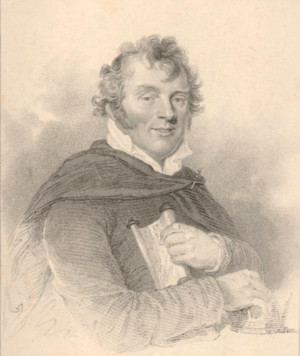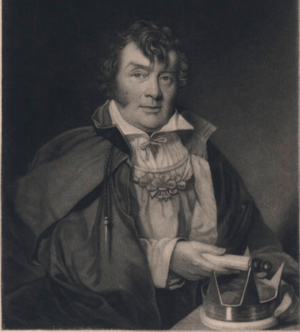Roger O'Connor facts for kids
Quick facts for kids
Roger O'Connor
|
|
|---|---|

Roger O'Connor, as depicted on the frontispiece to the Chronicles of Eri.
|
|
| Born | 1762 Connorville, County Cork, Ireland |
| Died | 1834 Kilcrea |
| Occupation | Polemicist; speculative historian |
| Period | Romantic era |
| Spouse | Louisa Strachan; Wilhamena Bowen |
| Children |
|
| Relatives |
|
Roger O'Connor (1762-1834) was an Irish writer and a strong supporter of Irish independence. He was known for his interesting life and his book, Chronicles of Eri, which told a unique story of Irish history. Roger was the brother of Arthur O'Connor, who was part of the Society of United Irishmen. He was also the father of Feargus O'Connor, a leader in the Chartist movement, and Francisco Burdett O'Connor, who fought in wars for independence in South America.
Contents
Early Life and Irish Nationalism
Roger O'Connor was born in 1762 in Connorville, County Cork, Ireland. His family was Protestant. He studied law and became a lawyer in 1784. Roger married Louisa Anna Strachan, and they had two children. After she passed away, he married Wilhamena Bowen in 1788, and they had seven more children.
Family and Political Beliefs
Roger's younger brother, Arthur O'Connor, was a member of the United Irishmen. This group wanted Ireland to be independent from British rule. Roger also supported this movement. He even helped edit a nationalist newspaper called Harp of Erin.
Some of Roger's other brothers supported the British. This caused disagreements within his family. Roger faced difficulties because of his nationalist activities. He was even arrested and held in different places for several years. However, he always said he was innocent of any serious crimes.
In 1799, Roger wrote a booklet called To the People of Great Britain and Ireland. In it, he explained what he felt was unfair treatment by the authorities. Many important people, including British politicians, supported him. One politician, Richard Brinsley Sheridan, said Roger was a "fine fellow" and had been treated "mercilessly." Roger was held in Fort George in Scotland until 1801. He was then moved to London and was not allowed to go back to Ireland for a while.
Life at Dangan Castle
In 1803, Roger O'Connor was finally allowed to return to Ireland. He moved to Dangan Castle in County Meath. This castle was once the childhood home of Arthur Wellesley, who later became a famous general. Roger said he got the castle as a place to welcome Napoleon, hoping the British would be defeated.
While living at Dangan, Roger began writing. He wrote about the Old Testament, but he had his own unique ideas about religion.
Castle Fire and Family Changes
Roger's wife, Wilhamena, passed away in 1806. After her death, his behavior became more unusual. In 1809, a large part of Dangan Castle was destroyed by fire. Years later, his son Francisco said that he had accidentally started the fire while melting lead for bullets.
Roger faced more challenges during this time. His teenage sons, Feargus and Francis, left home and went to London. They were taken in and cared for by Roger's friend, Sir Francis Burdett. Roger's oldest son, Roderic, moved to Australia.
The Chronicles of Eri
While in Paris, Roger O'Connor wrote his most famous book, Chronicles of Eri. It was published in 1822. The book claimed to be a translation of very old writings about the early history of the Irish people. Roger dedicated the book to his friend, Sir Francis Burdett.
The book included a picture of Roger holding a crown. The caption said he was the "Head of his Race" and "Chief of the prostrated people of his nation." Roger believed he was a direct descendant of a 12th-century Irish king, Ruaidrí Ua Conchobair.
Roger said he had tried to write this book three times before. He claimed his enemies had stolen his earlier writings. He also said another version of the book was destroyed in the Dangan Castle fire.
What the Book Was About
The Chronicles of Eri told a story of the Irish people, called Gaels, starting from ancient times. It claimed they came from the Phoenicians, then moved to Scythia, Spain, and finally to Ireland. Roger used stories from the Bible and old Irish legends to support his ideas. However, many historians believe the book was mostly made up by Roger O'Connor himself.
Later Years and Legacy
Roger O'Connor eventually returned to County Cork, Ireland. He had lost much of his money. He spent his final years living in a small cottage in Ballincollig.
His oldest son, Roderic O'Connor, became an important landowner and public official in Tasmania, Australia. Two of Roger's sons, Feargus O'Connor and Francisco Burdett O'Connor, were raised by Sir Francis Burdett. Feargus became a major leader in the Chartist movement, which fought for workers' rights in Britain. Francisco became a commander in Simón Bolívar's army and later a politician in Bolivia.
How People Remembered Him
People had different opinions about Roger O'Connor. Some said he was very brave in standing up for Ireland. Others thought he was a bit unusual. Historian James Dunkerley said that the Chronicles of Eri was a "colourful concoction," meaning it was a very imaginative story.
Roger was known for being charming and persuasive when he spoke. However, his writings were often described as very dramatic and exaggerated. He was a unique figure in Irish history, known for his strong beliefs and his imaginative stories.
|



